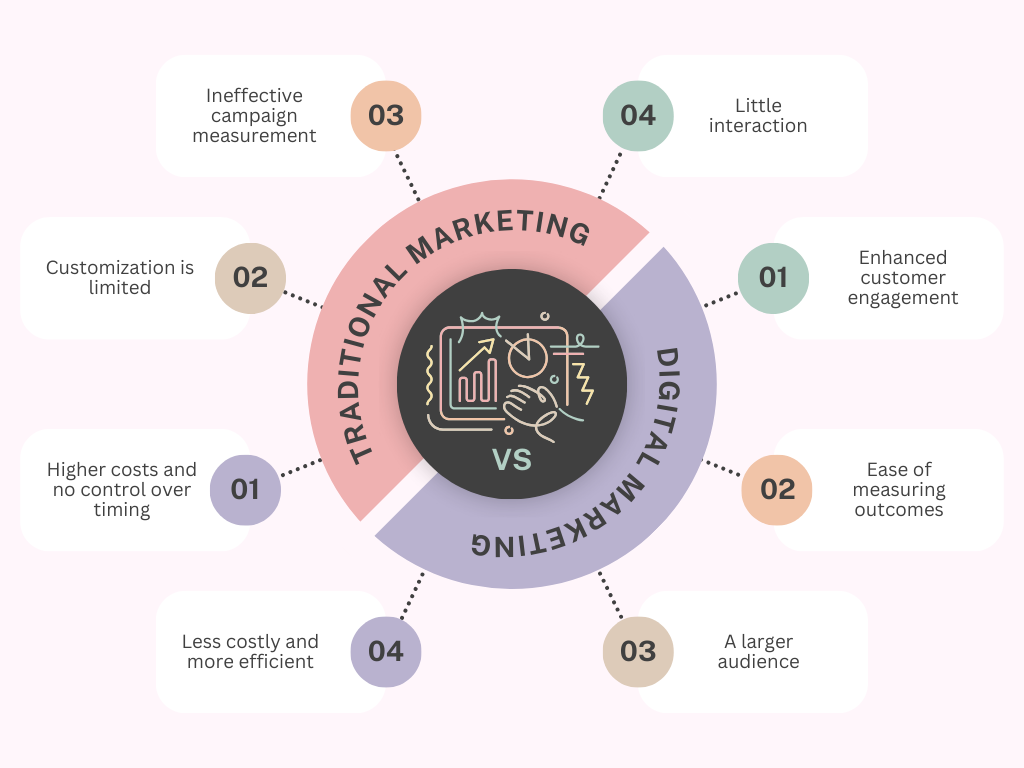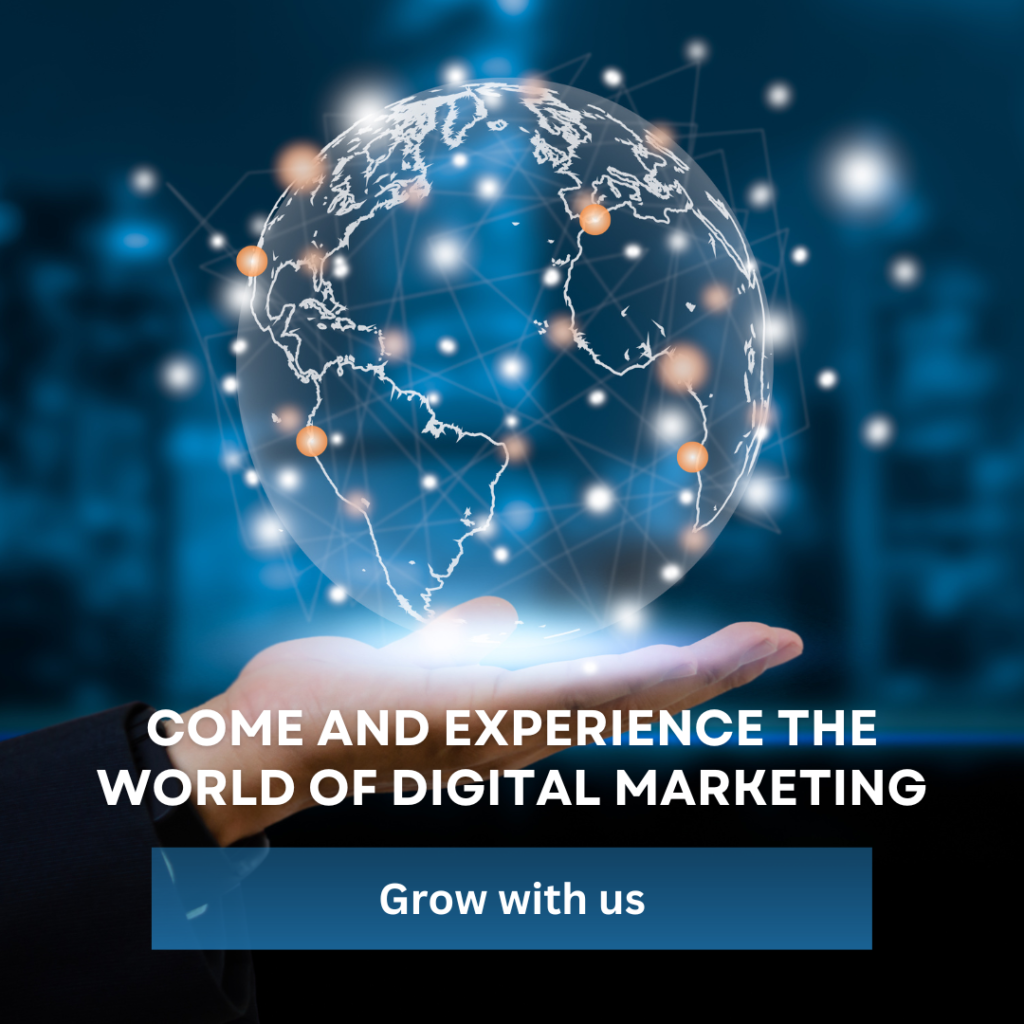Table of Contents
ToggleTop 4 Points Of Traditional vs. Digital Marketing : A Comparative Analysis

A Comparative Analysis In the ever-evolving landscape of marketing, two distinct approaches have emerged as dominant players: Traditional Marketing and Digital Marketing. While both aim to achieve the same goal of promoting products or services to a target audience, they employ vastly different strategies, tactics, and mediums. This comprehensive analysis delves into the intricacies of each method, highlighting their respective strengths, weaknesses, and suitability in today’s dynamic business environment.
Definition and OverviewTraditional Marketing:

A comparative analysis reveal that Traditional marketing encompasses conventional methods of advertising and promotion that have been utilized for decades. This includes print advertisements in newspapers and magazines, broadcast advertisements on television and radio, direct mail, outdoor billboards, and in-person sales presentations. These methods rely heavily on offline channels to reach potential customers. Digital Marketing: Studies have also proved in A comparative analysis in the field of Digital marketing, on the other hand, leverages digital technologies and online platforms to connect with target audiences.
This encompasses a wide range of tactics, derived from A Comparative analysis , include search engine optimization (SEO), social media marketing(SMM), content marketing, email marketing, pay-per-click (PPC) advertising, and affiliate marketing. Digital marketing allows for precise targeting, real-time analytics, and a more personalized approach to engaging with consumers.
Key Differences Reach and Accessibility: Result of A Comparative Analysis
Traditional Marketing
Traditional Marketing: While traditional methods can have broad reach, they are often limited by geography and audience segmentation. Print ads are confined to specific publications, and TV ads are restricted by time slots and channels.
Digital Marketing:

Digital platforms offer unparalleled reach and accessibility, allowing businesses to target specific demographics, interests, and behaviors. With the global reach of the internet, digital marketing campaigns can transcend geographical boundaries and engage with audiences worldwide.
Cost-effectiveness

Amazing result of the study of A Comparative Analysis is appended below
Traditional Marketing:
Traditional marketing tactics can be expensive, especially for small businesses with limited budgets. Print advertisements, television commercials, and direct mail campaigns often require substantial financial investment without guaranteed returns.
Digital Marketing:
Digital marketing offers more cost-effective solutions, with many channels allowing for precise targeting and pay-per-click pricing models. This enables businesses to optimize their advertising budgets and allocate resources more efficiently based on performance metrics.
Measurability and Analytics: A Comparative Analysis

Traditional Marketing:
Measuring the effectiveness of traditional marketing campaigns can be challenging. While techniques like coupon codes and customer surveys provide some insights, tracking ROI and attributing sales directly to specific advertisements can be ambiguous.
Digital Marketing:
One of the most significant advantages of digital marketing is the ability to track and analyze campaign performance in real-time. Metrics such as website traffic, conversion rates, click-through rates, and customer engagement provide valuable data for optimizing strategies and maximizing ROI.Interactivity and Engagement:
Traditional Marketing:
Traditional marketing channels are often one-way communication mediums, where brands broadcast messages to passive audiences. While memorable advertisements can leave a lasting impression, there is limited opportunity for direct interaction or engagement.
Digital Marketing:
Digital platforms facilitate two-way communication between brands and consumers, fostering engagement, dialogue, and relationship-building. Social media platforms, in particular, enable brands to interact directly with customers, respond to feedback, and cultivate brand loyalty through authentic interactions.
Adaptability and Flexibility

Traditional Marketing:
Traditional marketing campaigns typically require extensive planning and lead time to execute. Changes or adjustments to messaging, creative assets, or distribution channels can be cumbersome and time-consuming.
Digital Marketing:
Digital marketing campaigns are inherently more agile and adaptable. With the ability to make real-time adjustments based on performance data and market trends, businesses can quickly optimize campaigns, test new strategies, and respond promptly to changing consumer behavior.Integration and Synergy While traditional and digital marketing are often portrayed as competing approaches, the most successful marketing strategies often integrate elements of both. This hybrid approach capitalizes on the strengths of each method while mitigating their respective weaknesses. For example:Omni-channel Marketing: Combining traditional and digital channels to create a seamless and cohesive customer experience across multiple touchpoints.
Integrated Campaigns

Leveraging traditional mediums for brand awareness and digital channels for engagement and conversion, creating a unified marketing message that resonates with target audiences.Data-driven Insights: Using analytics from digital marketing campaigns to inform and optimize traditional marketing efforts, maximizing the impact and effectiveness of both channels.ConclusionIn the dynamic landscape of modern marketing, the dichotomy between traditional and digital approaches is becoming increasingly blurred. While traditional methods still hold relevance and can be effective in certain contexts, the rise of digital technologies has transformed the way businesses connect with consumers.
Ultimately, the most successful marketing strategies leverage the strengths of both traditional and digital channels, adapting to evolving consumer behavior and market trends to achieve optimal results.
A COMPARATIVE ANALYSIS : CONCLUSION

Exhaustive study of A Comparative Analysis have prooved that by embracing innovation, creativity, Social Media Marketing, Online Business, Search Engine Optimization, Social Media Optimization and data-driven insights, businesses can navigate the complexities of today’s digital marketing landscape and drive sustainable growth in an ever-changing world.
